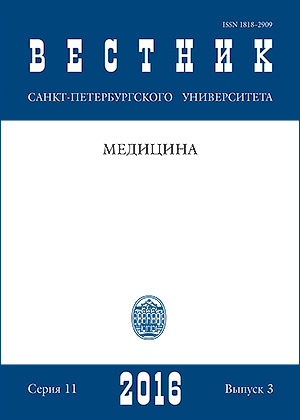PARADOXICAL EFFECTS OF ANTIOXIDANT ACTION IN THE PHOTOHAEMOLISIS SYSTEM
DOI:
https://doi.org/10.21638/11701/spbu11.2016.309.Abstract
The influence of Mexidol (solution for intravenous administration, “PHARMASOFT Ltd”.) in its therapeutic
(0,24–3,9 μg/мл) and more high (15,6 μg/мл) concentrations on photo induced lysis (with Radachlorin, “RADAPHARMA Ltd”, as a photo sensitizer and a monochrome diode 653 nm as a light source) of donor RBC was under study. Strong acceleration a photo induced haemolysis was found in Mexidol presence evidencing the preparation prooxidant action. The grade of the photo induced haemolysis acceleration was rising with the increase of Mexidol concentration up to 3,9 μg/мл. High Mexidol concentration (15,6 μg/мл) still remaining prooxidative were less effective than some of therapeutic concentrations. The spectral analysis showed that therapeutic mexidol concentrations (0,24–3,9 μg/мл) didn’t change absorption maximum of Radachlorin in its “red” maximum. High Mexidol concentration (15,6 μg/мл) caused a hypochromic shift of the “red peak”, and its decrease that is in agreement with our data on photo induced haemolysis. Possible mechanisms of Mexidol prooxidant activity in photoinduced haemolisis system are discussed. Refs 12. Fig. 1. Tabl. 2.
Keywords:
prooxidant, antioxidant, photo-induced haemolysis, photo sensitizer, erythrocyte
Downloads
References
References
Modifikatsiia obmena lipidov pri pankreatite pod vliianiem meksidola [Modifications of Lipid Metabolism
at Pancreatitis under Mexidol Action]. Experimantal and Clinical Pharmacology, 2003, vol. 66, no. 1, pp. 40–45. (In Russian)
Downloads
Published
How to Cite
Issue
Section
License
Articles of "Vestnik of Saint Petersburg University. Medicine" are open access distributed under the terms of the License Agreement with Saint Petersburg State University, which permits to the authors unrestricted distribution and self-archiving free of charge.




